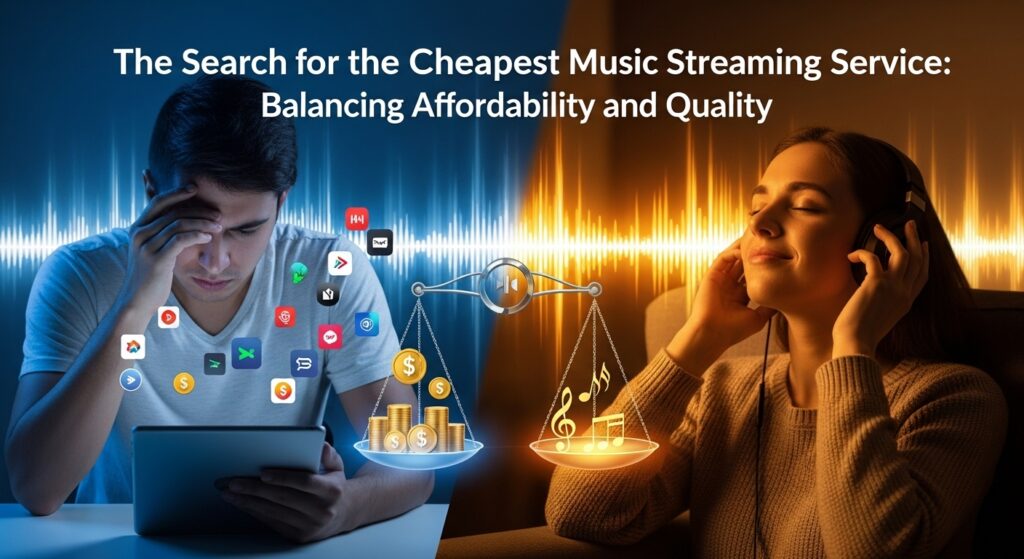In today’s rapidly evolving digital age, music consumption has shifted dramatically. Gone are the days when listeners relied solely on CDs, vinyl, or digital downloads. Instead, music streaming services dominate the landscape, offering access to millions of songs at the tap of a finger. For many listeners, however, the challenge isn’t access—it’s affordability. With multiple platforms competing for attention, users are increasingly asking a crucial question: what is the cheapest music streaming service that still delivers value?
This article explores the landscape of affordable music streaming, the balance between cost and quality, and why the cheapest music streaming service may not always be the “best” but can certainly provide exceptional opportunities for budget-conscious listeners.
Why Affordability Matters in Music Streaming
Music streaming has democratized access to sound. Listeners no longer need to spend hundreds on albums when they can stream nearly unlimited music for a small monthly fee. However, as streaming subscriptions multiply, costs can add up quickly—especially for students, families, and casual listeners who don’t want to overspend on music.
For this reason, many people actively search for the cheapest music streaming service that provides:
-
A wide catalog of songs and albums.
-
Decent sound quality for casual or critical listening.
-
User-friendly apps across devices.
-
Extra features like offline downloads, curated playlists, and podcast integration.
The focus is not only on saving money but also on ensuring the experience remains enjoyable and practical.
Defining the “Cheapest Music Streaming Service”
When people think of “cheap,” they often assume it means sacrificing features. However, affordability in streaming is about finding the best balance between cost and value. While free, ad-supported platforms like Spotify Free or YouTube Music Free exist, they often come with limitations—ads, lower-quality sound, and fewer offline options.
Thus, the true search for the cheapest music streaming service focuses on paid plans that are:
-
Low-cost monthly or yearly subscriptions.
-
Flexible options such as student discounts, family sharing, or bundle deals.
-
No compromise on core features like accessibility, sound, and catalog size.
Comparing Popular Streaming Services
To understand the market, let’s briefly compare major players often considered by those searching for the cheapest music streaming service:
-
Spotify – Known for its free tier and wide global availability. Premium plans are affordable, with discounts for students and families.
-
Apple Music – Slightly more expensive than some competitors but integrates seamlessly with iOS and offers lossless audio.
-
Amazon Music – Competitive pricing, especially for Amazon Prime members who get discounted rates.
-
YouTube Music – Affordable, with strong integration with YouTube for official and user-generated content.
-
Deezer & Tidal – Cater to audiophiles but may cost more unless using special deals.
-
Smaller services like Pandora (U.S.-only) or regional apps sometimes undercut global giants with localized pricing.
Ultimately, affordability often depends on personal circumstances. For example, students may find Spotify Premium Student unbeatable, while Prime users might lean toward Amazon Music as the cheapest music streaming service for them.
The Role of Free Tiers
While this article emphasizes affordable paid options, it’s worth noting the value of free tiers. Free versions of Spotify, YouTube Music, and Pandora let listeners enjoy music without paying a dime. However, ads, limited skips, and lower audio quality often push users toward at least the entry-level paid subscriptions.
This reinforces the idea that the cheapest music streaming service is not always “free,” but the one that balances minimal cost with essential features.
Value Beyond Price
When exploring the cheapest music streaming service, it’s important not to focus solely on cost. Here are key factors that can elevate the experience:
-
Music Discovery: Algorithms that recommend songs based on listening habits can enhance enjoyment.
-
Cross-Platform Support: Access on smartphones, desktops, smart speakers, and even cars.
-
Exclusive Content: Some platforms offer exclusive albums, early releases, or live sessions.
-
Offline Listening: Essential for users who travel or have limited data.
By evaluating these features, users ensure they are not simply choosing the cheapest service, but the one that aligns best with their lifestyle.
The Digital Age Influence
One reason affordability in streaming matters so much today is the rise of digital-first lifestyles. Younger generations, particularly Millennials and Gen Z, grew up in a subscription-based economy. From Netflix to Spotify, the expectation is not ownership but access at a fair cost.
In this environment, the cheapest music streaming service is not just about saving money—it reflects a broader cultural shift toward accessibility, personalization, and inclusivity.
Challenges in the Search for Affordability
Despite the benefits, there are challenges when searching for the cheapest music streaming service:
-
Regional Availability – Pricing varies widely by country. What is cheapest in one region may not exist in another.
-
Hidden Costs – Some platforms limit features behind premium tiers, meaning users must pay more for the full experience.
-
Music Rights & Catalog Limitations – Smaller services may not have the same song library as global giants.
Still, these challenges also create opportunities. Services regularly experiment with student bundles, family sharing, or promotional deals that make premium music more affordable than ever before.
Opportunities for Innovation
The affordability race has pushed platforms to innovate. For example:
-
Bundle Services: Amazon combining music with Prime Video and shopping benefits.
-
Student Discounts: Spotify including perks like Hulu in some markets.
-
Regional Plans: Platforms offering extremely low-cost plans in developing countries to attract new users.
This competitive innovation ensures that the cheapest music streaming service often gets better over time—providing more features for less money.
Looking Ahead
The future of affordable streaming will likely see:
-
More personalized pricing models based on listening habits.
-
Ad-supported hybrid options where users watch a few ads for cheaper access.
-
Increased integration with smart homes, cars, and wearable devices.
As music remains central to culture and identity, streaming services will continue to balance profitability with inclusivity—making sure that music remains accessible to everyone, regardless of budget.
Conclusion
The hunt for the cheapest music streaming service is not just about saving money; it’s about redefining how listeners experience music in the modern era. Whether through Spotify’s student discounts, Amazon’s bundle deals, or YouTube Music’s integration with video content, users today have more affordable options than ever before.
The key is to weigh cost against value: Does the service offer the catalog, features, and convenience you need at a price you can sustain? By making informed choices, listeners can enjoy the best of both worlds—affordable access to music and a quality experience that enriches daily life.
In the end, the cheapest music streaming service is the one that makes your listening experience seamless, enjoyable, and sustainable—without breaking the bank.





